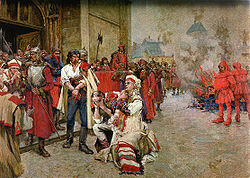- Croatian–Slovenian peasant revolt
-
 A non-contemporary representation of the execution of Matija Gubec at the square in front of st. Mark's Church in Zagreb, by Oton Iveković
A non-contemporary representation of the execution of Matija Gubec at the square in front of st. Mark's Church in Zagreb, by Oton Iveković
The Croatian-Slovenian peasant revolt of 1573 was a large peasant revolt in today's Croatia and Slovenia. The revolt, sparked by cruel treatment of serfs by the baron Franjo Tahy, ended after 12 days with the defeat of the rebels and bloody retribution by the nobility.
Contents
Background
In the late 16th century, the threat of Ottoman incursions strained the economy of the southern flanks of the Holy Roman Empire, and feudal lords continually increased their demands on the peasantry. In Croatian Zagorje, this was compounded by cruel treatment of peasants by baron Franjo Tahy and his warring with neighbouring barons over land. When multiple complaints to the emperor went unheard, the peasants conspired to rebel with their peers in the neighbouring provinces of Styria and Carniola and with the lower classes of townspeople.
Revolt
The rebellion broke out simultaneously in large parts of Croatia, Styria, and Carniola on 28 January 1573. The rebels' political program was to replace the nobility with peasant officials answerable directly to the emperor, and to abolish all feudal holdings and obligations of the Roman Catholic Church. A peasant government was formed with Matija Gubec,[1] Ivan Pasanac and Ivan Mogaić as members. Far-reaching plans were drawn up, including abolition of provincial borders, opening of highways for trade, and self-rule by the peasants.
The captain of the rebels, Ilija Gregorić, planned an extensive military operation to secure victory for the revolt. Each peasant household provided one man for his army, which met with some initial success; their revolutionary goals alarmed the nobility, however, which raised armies in response.
Backlash
On 5 February, imperial captain Turn defeated Ilija Gregorić and 2,000 men near the Lower Styrian town of Brežice. The next day, another rebel force was subjugated near Samobor. On 9 February, the decisive Battle of Stubičko polje was fought. Gubec and his 10,000 men resisted fiercely, but after a bloody four-hour battle the baronal army defeated and captured Gubec. The revolt failed.
Retribution was brutal: in addition to the 3,000 peasants who died in the battle, many captives were hanged or maimed. Matija Gubec was publicly tortured and executed on 15 February.
Legacy
The revolt and torture of Gubec acquired legendary status in Croatia and Slovenia. It has inspired many writers and artists, including the writers Miroslav Krleža and August Šenoa, the poet Anton Aškerc and the sculptors Antun Augustinčić and Stojan Batič. A museum near Oršić Castle in Gornja Stubica and one in Krško (Slovenia) are dedicated to the revolt.
See also
References
- ^ Vojna enciklopedija. Belgrade: Redaction of Vojna enciklopedija. 1972. pp. book 3, p 347.
External links
Categories:- Peasant revolts
- Popular revolt in late-medieval Europe
- Medieval Croatia
- History of Slovenia
- 1573 in Europe
- Conflicts in 1573
- 16th century in Croatia
- 16th-century rebellions
Wikimedia Foundation. 2010.
